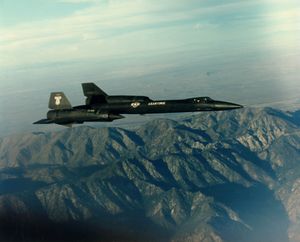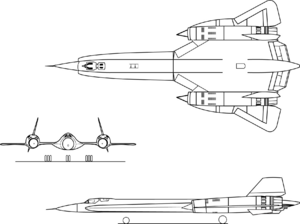PlaneSpottingWorld welcomes all new members! Please gives your ideas at the Terminal.
Lockheed YF-12
| YF-12 | |
|---|---|
| YF-12A undergoing flight testing. | |
| Type | Interceptor |
| Manufacturer | Lockheed Corporation |
| Designed by | Clarence "Kelly" Johnson |
| Maiden flight | July 1962 |
| Status | Cancelled |
| Primary user | United States Air Force |
| Number built | 3 |
| Unit cost | US$15-18 million (projected)[1] |
| Developed from | A-12 OXCART |
The Lockheed YF-12 was a prototype interceptor aircraft, one of several variants of the CIA's highly-secret A-12 OXCART that also spawned the now-famous SR-71 Blackbird.
Contents
History
The United States Air Force (USAF) YF-12 program was a development of the A-12 OXCART spy plane designed for the CIA and first flown in 1962. Lockheed was able to interest the Air Force in the project after the USAF had been forced to cancel the XF-108 Rapier, a Mach 3-capable interceptor intended to replace the F-106 Delta Dart in service. It was pointed out that an aircraft based on the A-12 would provide a less costly alternative to the XF-108, since much of the design and development work on the YF-12 had already been done and paid for. In 1960 the USAF agreed to take the 11th through 13th slots on the A-12 production line and have them completed in the YF-12A interceptor configuration.
The main changes involved modifying the aircraft's nose to accommodate the Hughes AN/ASG-18 fire-control radar originally developed for the XF-108, and the addition of a second cockpit for a crewmember to operate the fire control radar. The nose modifications changed the aircraft's aerodynamics enough to require ventral fins to be mounted under the fuselage and engine nacelles to maintain stability. Finally, bays previously used to house the A-12's reconnaissance equipment were converted to carry missiles.
Tests were very impressive: the YF-12As set a number of new speed and altitude records, and demonstrated promising results with their unique weapon system. Six successful firings of the AIM-47 missiles were completed, the last one launched from the YF-12 at Mach 3.2 at an altitude of 74,400 feet (22,677 meters) to a target drone B-47 500 feet (152 m) off the ground. In 1965 the Air Force placed an order for 93 F-12Bs, but this was cancelled due to budget cuts by Secretary of Defense Robert McNamara. The rationale for the cancellation was, in part, the belief that the Soviet Union did not possess a bomber fast enough to warrant the investment in an interceptor of this speed. The program was abandoned at that point, but the YF-12s continued flying for many years with the United States Air Force and with NASA as research aircraft.
Of the three YF-12As, #60-6934 was damaged beyond repair by fire at Edwards AFB during a landing mishap on August 14, 1966; its rear half was salvaged and combined with the front half of a Lockheed static test airframe to create the one and only SR-71C. That aircraft (nicknamed "The Bastard" by its pilots, as it did not fly quite straight, and required the pilot to hold some rudder pressure at cruise) today is on display at a museum at Hill AFB, UT. It is unique among all SR-71's as it still carries the ventral fins under its nacelles – an artifact of its YF-12 lineage which does not exist on any other SR-71. YF-12A #60-6936 was lost June 24, 1971 due to an in-flight fire caused by a failed fuel line; both pilots ejected safely just north of Edwards AFB. YF-12A #60-06935 is the only surviving YF-12A; it is on display at the National Museum of the United States Air Force at Wright-Patterson Air Force Base near Dayton, Ohio.
A fourth YF-12-series aircraft, the YF-12C, was actually not a YF-12 at all; it was an Air Force SR-71A (#417951) loaned to NASA a month after the loss of YF-12A #60-6936 in 1971, for the purposes of allowing NASA to complete propulsion tests originally slated for the lost YF-12. The SR-71A was re-designated as a YF-12C and reused serial number #60-6937, the serial number of the 11th A-12, that, like the rest of the OXCART fleet, had been retired three years earlier, in 1968, and was in storage at Palmdale. #417951 was operated (as #60-6937) by NASA until September of 1978, when it was returned to the Air Force. This aircraft is today on display at the Pima Air Museum in Tucson, AZ.
| Serial number | Model | Location or fate |
|---|---|---|
| 60-6934 | YF-12A | Transformed into SR-71C 64-17981 after fire damage in 1966 |
| 60-6935 | YF-12A | U.S. Air Force Museum, Wright-Patterson AFB, OH |
| 60-6936 | YF-12A | Lost, 24 June 1971 |
Specifications (YF-12A)
Data from Lockheed's SR-71 'Blackbird' Family; Goodall, James, and Miller, Jay; Midland Publishing, Hincley, England, 2002.
General characteristics
- Crew: 2
- Length: 101 ft 8 in (30.97 m)
- Wingspan: 55 ft 7 in (16.95 m)
- Height: 18 ft 6 in (5.64 m)
- Wing area: 1,795 ft² (167 m²)
- Empty weight: 60,730 lb (27,604 kg)
- Max takeoff weight: 124,000 lb (56,200 kg)
- Powerplant: 2× Pratt & Whitney JTD11D-20A high-bypass-ratio turbojet with afterburner
- Dry thrust: 20,500 lbf (91.2 kN) each
- Thrust with afterburner: 31,500 lbf (140 kN) each
Performance
- Maximum speed: Mach 3.35 (2,200 mph, 3,500 km/h) 80,000 ft
- Range: 3,000 mi (4,800 km)
- Service ceiling: 90,000 ft (24,000 m)
Armament
- Missiles: 3× Hughes AIM-47A air-to-air missiles located internally in fuselage bays
Avionics
- Hughes AN/ASG-18 look-down/shoot-down fire control radar
YF-12 aircraft on display
The sole remaining YF-12A is located:
Notes and references
- ↑ Knaack, Marcelle Size (1978). Encyclopedia of US Air Force aircraft and missile systems. Office of Air Force History.
External links
- Mach 3+: NASA/USAF YF-12 Flight Research, 1969-1979 by Peter F. Merlin (PDF book)
- USAF Museum: YF-12
- SR-71 Online - YF-12A #60-6935 Photos
- Blackbird Spotting maps the location of every existing Blackbird, with aerial photos from Google Maps
- USAF Aircraft Serial Numbers for 1960, including all A-12s, YF-12As, and M-21s
- USAF Aircraft Serial Numbers for 1961, including all SR-71s
Related content
Related development
Designation sequence
Related lists
See also
Airliners and Civil Transports: Vega · Electra · Electra Junior · Super Electra · Lodestar · Constellation · Saturn · L-188 Electra · L-402 · JetStar · L-1011 TriStar
Military Transports : C-64 · C-121 · R6V · C-130 Hercules · C-141 Starlifter · C-5 Galaxy
Fighters: F-22 Raptor · F-35 Lightning II · F-94 Starfire · F-104 Starfighter · F-117 Nighthawk · P-38 Lightning · P-80 Shooting Star · T-33 Shooting Star
Patrol and reconnaissance : Hudson · PV-1 Ventura · PV-2 Harpoon · P-2 Neptune · P-3 Orion · CP-140 Aurora/CP-140A Arcturus · U-2 · SR-71 Blackbird · S-3 Viking
Lists relating to aviation | |
|---|---|
| General | Timeline of aviation · Aircraft · Aircraft manufacturers · Aircraft engines · Aircraft engine manufacturers · Airports · Airlines |
| Military | Air forces · Aircraft weapons · Missiles · Unmanned aerial vehicles (UAVs) · Experimental aircraft |
| Notable incidents and accidents | Military aviation · Airliners · General aviation · Famous aviation-related deaths |
| Records | Flight airspeed record · Flight distance record · Flight altitude record · Flight endurance record · Most produced aircraft |


